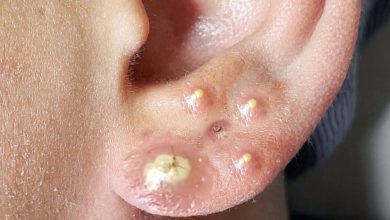47-Year-Old Male’s Jaw-Dropping Tartar Removal: Comprehensive Scaling Treatment
When it comes to dental health, many individuals may underestimate the importance of regular professional cleanings and the impact that neglected oral hygiene can have on their overall well-being. In this article, we’ll dive into a remarkable case of a 47-year-old male who underwent a comprehensive scaling treatment to remove years of built-up tartar. This procedure not only restored his smile but also helped prevent potential future oral health issues, such as gum disease and tooth loss.
The Story Behind the Tartar Build-Up

For many adults, maintaining consistent oral hygiene routines can be challenging. Busy lifestyles, lack of awareness, or even avoidance of dental visits can lead to the accumulation of plaque, which over time hardens into tartar (also known as calculus). Unlike plaque, tartar can’t be removed by regular brushing alone and requires professional intervention to be eliminated.
In this particular case, the 47-year-old male had not had a professional dental cleaning in several years. As a result, plaque had gradually hardened into thick, stubborn tartar deposits along his gum line and between his teeth. Tartar buildup is often visible as yellow or brownish stains on the teeth and can extend both above and below the gumline.
What is Tartar, and Why is It a Problem?

Tartar is a hard, mineralized substance that forms when plaque on your teeth mixes with minerals in your saliva. Over time, if plaque is not removed, it becomes tartar, which is not only difficult to remove but also serves as a breeding ground for harmful bacteria.
If left unchecked, tartar can lead to a number of serious dental problems, such as:
- Gum Disease (Gingivitis and Periodontitis): Tartar buildup irritates the gums, causing them to become inflamed, bleed, and potentially recede. This can lead to infections and even tooth loss if untreated.
- Tooth Decay: The bacteria in tartar produce acids that erode tooth enamel, leading to cavities and decay.
- Bad Breath: Tartar can contribute to persistent bad breath (halitosis) due to the bacteria it harbors.
Given the extent of tartar buildup in this 47-year-old patient’s case, his dentist recommended a thorough scaling procedure to restore his oral health.
The Scaling Procedure: What to Expect

Scaling is a non-surgical dental procedure performed by a trained dental hygienist or dentist to remove tartar and plaque from the surface of the teeth and beneath the gumline. Here’s a breakdown of the steps involved in the treatment:
- Initial Assessment and X-Rays: Before the scaling treatment begins, the dentist conducts a comprehensive oral exam, often using X-rays to check for any underlying issues, such as cavities or bone loss, that may have been caused by the tartar buildup.
- Local Anesthesia (if needed): For patients with heavy tartar buildup, local anesthesia may be administered to ensure comfort during the procedure. This is especially important if tartar has accumulated below the gumline, which can cause sensitivity during removal.
- Ultrasonic Scaling: The dentist uses an ultrasonic scaler, a tool that vibrates at a high frequency to break up large pieces of tartar. The device also uses a gentle stream of water to wash away debris and keep the area clean. This method is effective for removing the majority of tartar without causing discomfort.
- Hand Scaling (for finer tartar): After the ultrasonic scaler, hand instruments may be used to fine-tune the cleaning process. These instruments allow the dentist to remove any remaining tartar near the gumline or in hard-to-reach areas.
- Polishing: Once all tartar and plaque have been removed, the teeth are polished to smooth the surface and reduce the likelihood of future plaque buildup. A polishing paste is applied, and the teeth are gently buffed.
- Post-Treatment Care: After the scaling procedure, the dentist will provide care instructions, including tips for maintaining good oral hygiene and possibly recommending a follow-up appointment to monitor healing and prevent future tartar buildup.
The Immediate Results
After the scaling procedure, our 47-year-old patient experienced immediate improvement in both the appearance and feel of his teeth. The removal of the thick tartar revealed cleaner, brighter teeth. His gums, which had been irritated and inflamed from the tartar, began to show signs of recovery almost immediately. The patient reported a significant reduction in sensitivity, as the excess tartar no longer irritated his gums or tooth surfaces.
In addition to the visual improvement, the patient also noticed that his breath became fresher. Removing the bacteria-laden tartar helped eliminate one of the main causes of his chronic bad breath.
Long-Term Benefits of Scaling
The long-term benefits of scaling go beyond just a cleaner smile. Regular scaling treatments help ensure that your gums remain healthy, your teeth are free from decay, and you maintain overall oral health. For our 47-year-old patient, the treatment helped:
- Prevent Gum Disease: The removal of tartar reduced inflammation and bleeding, significantly lowering the risk of gum disease progressing into more severe stages.
- Preserve Teeth: Scaling prevents tooth decay and potential loss by eliminating the bacteria that erode tooth enamel.
- Enhance Oral Hygiene: The procedure serves as a fresh start, allowing the patient to focus on maintaining better oral hygiene going forward, with regular brushing and flossing.
Preventing Tartar Buildup: Tips for Ongoing Care

While scaling is an effective solution for removing existing tartar, the key to preventing future buildup lies in maintaining a consistent oral care routine. Here are some important tips for keeping your teeth tartar-free:
- Brush Twice a Day: Use a fluoride toothpaste and a soft-bristled toothbrush to brush your teeth thoroughly at least twice a day.
- Floss Daily: Flossing helps remove food particles and plaque from between your teeth and along the gumline.
- Use Antibacterial Mouthwash: An antibacterial mouthwash can help reduce plaque buildup and control bacteria.
- Visit Your Dentist Regularly: Regular dental check-ups and cleanings are crucial in preventing tartar buildup and detecting potential issues early.
- Avoid Tobacco Products: Smoking or chewing tobacco can accelerate tartar buildup and increase the risk of gum disease.
A comprehensive scaling treatment is a powerful tool in restoring dental health, as demonstrated by the dramatic results seen in this 47-year-old male patient. By removing years of built-up tartar, the patient not only improved the appearance and health of his teeth but also significantly reduced his risk of future dental complications.
If you’re due for a professional cleaning or suspect that tartar is building up on your teeth, don’t wait for more serious issues to develop. Schedule a dental check-up today to keep your smile looking its best and your oral health in top shape.
Remember: Good oral hygiene habits combined with regular professional care can go a long way in preserving your teeth and gums for years to come.





